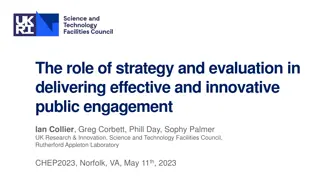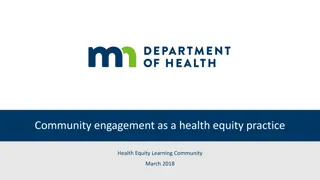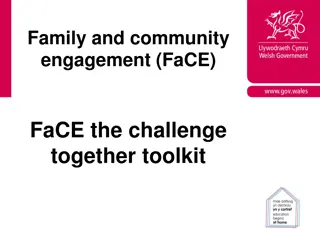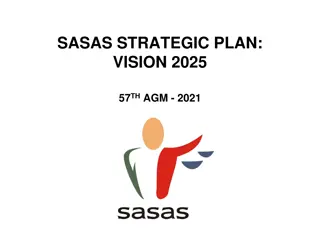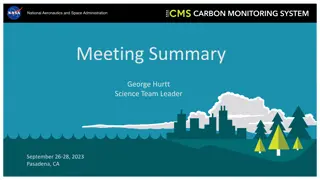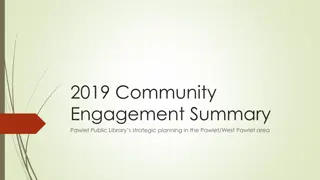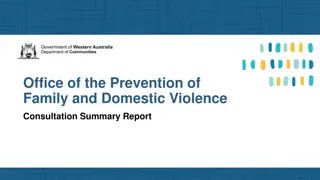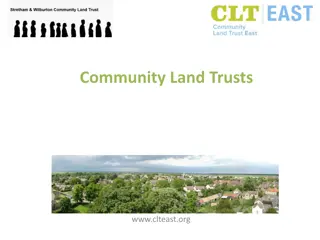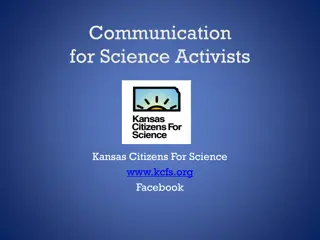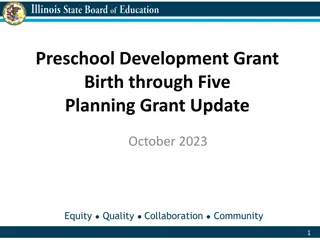Science Community Engagement and ATST Development Summary
Science community engagement and development of the Advanced Technology Solar Telescope (ATST) are critical for the success of the project. The formation of core groups, hosting ATST science meetings, and involving a wider US user community are key recommendations from reports and discussions. The Project has established regular science and technology meetings, aiming to bring together international solar telescope communities. The importance of organizing annual ATST Science Meetings is emphasized to keep the community engaged as the project progresses towards commissioning in 2017 and operational status by 2018/19. The establishment of a public face for ATST science and concerted efforts to involve a wider user community are vital for the success and sustainability of the ATST project.
Download Presentation

Please find below an Image/Link to download the presentation.
The content on the website is provided AS IS for your information and personal use only. It may not be sold, licensed, or shared on other websites without obtaining consent from the author.If you encounter any issues during the download, it is possible that the publisher has removed the file from their server.
You are allowed to download the files provided on this website for personal or commercial use, subject to the condition that they are used lawfully. All files are the property of their respective owners.
The content on the website is provided AS IS for your information and personal use only. It may not be sold, licensed, or shared on other websites without obtaining consent from the author.
E N D
Presentation Transcript
Original Idea: Smaller subset of SWG that is able to more rapidly and more frequently respond to issues/questions as they come up Members comprised of mostly instrument team leaders require frequent interaction with project anyway Are most effected by project decisions/developments (e..g. optics, polarimetry, ISRD requirements) Have met loosely to address specific issues: ISRD CO 4.7 micron requirements Occulting requirements Polarimetry working group (expanded beyond core0 Do we want/need to formalize more/organize better: Supposed to meet at least quarterly Pro: Need to improve interactions and communications between instrument teams Similar issues/problems Interfacing to telescope subsystems (cameras, DHS, optical, .) Con: community sentiments exclusion?
NSO UC Report 2010 The Committee expects that one of the biggest challenges for NSO will be creating and sustaining a US user community for the ATST. A public face of ATST science, based in the US, needs to start being developed through ATST science meetings within the US and ATST instrument US-centered science teams which extend beyond the actual instrument teams. These efforts are time critical, and are best addressed prior to commissioning. There should be a conscious effort to train/involve/encourage wider US participation in the user community for these instruments. ATST science meetings, in concert with a DST-instrument pathfinder program that includes promoting and distributing data from a DST instrument, will help avoid the perception that the ATST will be a facility primarily for the Principal Investigator teams. . A pathfinder (at DST) would serve, first, as a test bed for the ATST data pipeline and its integration with the NSO archive and Virtual Solar Observatory ( VSO ), and second, as a means of cultivating core groups of users outside of the immediate instrument team for each corresponding instrument.
Science Meetings Recommendation 3: The ATST project should begin planning annual ATST Science Meetings to be held either in concert with existing solar physics meetings or independently. It is anticipated that as completion nears, the meetings will be major independent meetings along the lines of the successful SOHO and Hinode science meetings. Project Response: The project has established regular science and technology meeting that is jointly organized by ATST and its European counterpart EAST. The first meeting was held in Freiburg in Oct. 2009. The meeting attracted about 100 participants and was very successful. The next ATST/EAST meeting will be held in 2 years in the US. We regard it as very important to bring together the international ground based solar telescope community and organize internationally around common goals. The ATST/EAST conference with its global reach serves this purpose well. In addition we will consider organizing ATST science meetings either standalone or in conjunction with e.g. the annual SPD meetings.
ATST Science Meetings Recognize importance of keeping community engaged How soon? ATST commissioning starts 2017. Operational 2018/19 Hinode is operating in year 4. Hinode4 just conducted. Before: SOT# - equivalent to ATST SWG Format? US? International? Cadence? 1-2 years? Venue? Context: EAST/ATST Workshop Freiburg 2009. ATST/EAST WS planned for 2011 US future of WS uncertain. Are there too many meetings already? How to maximize impact? Combine SWG and ATST Science Workshop? Discussed: SPD special session, IAU special session.
NSO UC Report 2010 The Committee expects that one of the biggest challenges for NSO will be creating and sustaining a US user community for the ATST. A public face of ATST science, based in the US, needs to start being developed through ATST science meetings within the US and ATST instrument US-centered science teams which extend beyond the actual instrument teams. These efforts are time critical, and are best addressed prior to commissioning. There should be a conscious effort to train/involve/encourage wider US participation in the user community for these instruments. ATST science meetings, in concert with a DST-instrument pathfinder program that includes promoting and distributing data from a DST instrument, will help avoid the perception that the ATST will be a facility primarily for the Principal Investigator teams. . A pathfinder (at DST) would serve, first, as a test bed for the ATST data pipeline and its integration with the NSO archive and Virtual Solar Observatory ( VSO ), and second, as a means of cultivating core groups of users outside of the immediate instrument team for each corresponding instrument.
Remote Ops from Maui Base Recommendation 4: Modern ground-based telescopes are complex facilities with tightly constrained operational budgets. In addition, the new generation of solar telescopes will require streamlined operational modes in which trained technicians will change the instruments to pre- planned configurations rapidly throughout the day it is unlikely that visiting scientist observers will be required to, or have any desire to, partake in instrument configuration changes. Thus in order to minimize cost while maximizing operational efficiency, the SWG strongly recommends that the number of personnel required at the telescope facility for daily operations be minimized. The SWG further recommends that the project investigate remotely controlling as many as possible instrument and telescope functions from the Maui Base facility, rather than at the telescope itself. Visiting scientist observers should be encouraged to visit the summit facility occasionally as educational opportunities, particularly for students, but not for daily operations. Project Reply: We will investigate the cost difference between remote ops and operations on the Mountain While. agreeing that minimizing the number of people traveling to the mountain on a daily basis is a sound goal, remote operations could be very expensive and complex and their cost was not part of the ATST Final Design Review and thus not within the current budget cap on the project. We will investigate what level of remote makes sense and is affordable. The theory is that we would be trading up front investment (construction budget) vs. operations cost. In principle, the goal makes sense. In practice, the implementation could be very expensive and time consuming and so far the assumption during D&D was that we will not implement full remote operations. We will discuss the implications within the project.
In order to minimize operations costs and minimize staff required directly at the ATST facility, restricted operations of the ATST facility from the Maui remote operations building (ROB) are desirable and will not be excluded by any ATST design implementation. Safety is a prime concern and only remote operations from the ROB for which safe procedures have been established and tested will be allowed. The NSO operations staff will initially operate at Haleakala only. During this initial operations period, which is expected to last for approximately 1 year, a remote operations plan for the ROB will be developed by the operations staff. The ROB-Ops plan will contain the safe and efficient operations procedure allowed to be executed from the ROB. A gradual transition from mountain only operations to ROB-Ops is expected. Since ROB-Ops were not part of the construction proposal, NSO will seek funding to implement remote operations. The necessary software/hardware interfaces need to implement remote operations will be available via the OCS, TCS and ICS. Definition?
What is Project Responsibility vs. NSO Responsibility? At a minimum ATST construction needs to mirror the mountain control capabilities, with the caveat of potentially limited display bandwidth duplicating mountain capabilities at the ROB is the no-cost option or is it? Hardware (monitors, computer infrastructure, network infrastructure) and additional software required for save and efficient ROB-OPS would be an NSO responsibility? The NSO would have to take charge of that part fairly soon and plan to allocate resources to the task. Any mandates on the construction budget for ROB-OPS would likely come out of the ATST instrumentation budget, which is already underfunded. A cost analysis should reveal what savings if any can likely be achieved from some level of ROB-OPS vs. all mountain ops. If for example, instrument scientist(s), RAs, certain engineering staff don t have to travel to the mountain every day but work from ROB one might save X*4h/day, where X is the number of people who don t travel. That times the number of work days/year times an average salary might be the annual savings. Depending on assumptions one might save several $100k/year, which is significant. Remote operations from anywhere else but the ROB are excluded at this point in time.
IV. Remote Observing, Remote Operations ATST will support remote definition of observing programs, i.e. instrument scientist and other designated personnel can develop observing programs using simulator software and then submit the resulting programs to the telescope control computers via an internet connection. Experience shows that this could be an operational nightmare Tools required? Are those NSO responsibility? Allow from ROB only
ATST will provide telescope status, pointing, and quick look images to ATST staff and proposal PIs at remote locations so they can monitor their runs. In addition, ATST will provide a publically accessible web site with real-time telescope pointing and (when appropriate) quick look images from various instruments. Quality assurance images are at very limited bandwidth Can the public site cover all needs?
Project Responsibility At a minimum ATST construction needs to mirror the mountain control capabilities, with the caveat of potentially limited display bandwidth. I understand that remote ops of any kind are not in the construction budget and duplicating mountain capabilities at the ROB is the no-cost option . Hardware (monitors, computer infrastructure, network infrastructure) and additional software required for save and efficient ROB-OPS would be an NSO responsibility. The NSO would have to take charge of that part fairly soon and plan to allocate resources to the task. Any mandates on the construction budget for ROB-OPS would likely come out of the ATST instrumentation budget, which is already underfunded. A cost analysis should reveal what savings if any can likely be achieved from some level of ROB-OPS vs. all mountain ops. If for example, instrument scientist(s), RAs, certain engineering staff don t have to travel to the mountain every day but work from ROB one might save X*4h/day, where X is the number of people who don t travel. That times the number of work days/year times an average salary might be the annual savings. Depending on assumptions one might save several $100k/year, which is significant. Remote operations from anywhere else but the ROB are excluded at this point in time.






